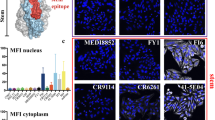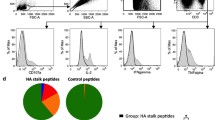Abstract
An extensive analysis was made of receptor specificity and gene usage in the neutralising antibody (mAb) and Class II-restricted T cell responses to influenza haemagglutinin (HA) following natural infection of MHC (H-2k or H-2d) congenic mice with X31 virus (H3N2 subtype). Despite the diversity of available antigenic sites on the HA1 subunit, there was strikingimmunodominance in the mAb response as deduced by sequencing the HA genes of escape mutants and the corresponding antibody H and L chain gene rearrangements. Similarly, Class II restricted T cell responses of individual donors focused on a single antigenic site, or immunodominant peptide; and PCR sequence analysis of T cell receptor (αβ) gene usage indicated that T cell memory was derived from asingle progenitor cell. Focusing of the immune repertoire to limited regions of the HA molecule during a primary viral infection may be a significant factor in immune pressure for antigenic variation.
Similar content being viewed by others
References
Wilson, I. A., Skehel, J. J. & Wiley, D. C. (1981) Structure of the haemagglutinin membrane glycoprotein of influenza virus at 3Å resolution.Nature,289:366.
Webster, R. G. & Laver, W. G. (1980) Determination of the number of non-overlapping antigenic areas on Hong Kong (H3N2) hemagglutinin with monoclonal antibodies and the selection of variants with potential epidemiological significance.Virology,104:139.
Ward, C. W. & Dopheide, T. A. (1981) Evolution of the Hong Kong influenza A subtype. Structural relationship between the hemagglutinin from A/duck/Ukraine/63 (Hav7) and the Hong Kong haemagglutinins.Biochem. J. 195:337.
Both, G. W., Sleigh, M. J., Cox, N. J. & Kendal, A. P. (1983) Antigenic drift in influenza virus H3 hemagglutinin from 1968 to 1980. Multiple evolutionary pathways and sequential amino acid changes at key antigenic sites.J. Virol. 48:52.
Laver, W. G., Air, G. M., Webster, R. G., Gerhard, W., Ward, C. W. & Dopheide, T. A. (1979) Antigenic drift in type A influenza virus: sequence differences in the hemagglutinin of Hong Kong (H3N2) variants selected with monoclonal hybridoma antibodies.Virology,98:226.
Wiley, D. C. & Skehel, J. J. (1987) The structure and function of the hemagglutinin membrane glycoprotein of influenza virus.Annu. Rev. Biochem. 56:365.
Mills, K. H. G., Skehel, J. J. & Thomas, D. B. (1986) Extensive diversity in the recognition of influenza virus hemagglutinin by murine T helper clones.J. Exp. Med. 163:1477.
Burt, D. S., Mills, K. H. G., Skehel, J. J. & Thomas, D. B. (1989) Diversity of the Class II (I-Ak/I-Ek) restricted T cell repertoire for influenza haemagglutinin and antigenic drift: six non-overlapping epitopes on the HA1 subunit are defined by synthetic peptides.J. Exp. Med. 170:383.
Barnett, B. C., Graham, C. M., Burt, D. S., Warren, A. P., Skehel, J. J. & Thomas, D. B. (1989) I-Ad restricted T cell recognition of influenza hemagglutinin: synthetic peptides identify multiple epitopes corresponding to antibody-binding regions of the HA1 subunit.J. Immunol. 143:2663.
Graham, C. M., Barnett, B. C., Hartlmayr, I., Burt, D. S., Faulkes, R., Skehel, J. J. & Thomas, D. B. (1989) The structural requirements for Class II (I-Ad) restricted T cell recognition of influenza hemagglutinin: B cell epitopes define T cell epitopes.Eur. J. Immunol. 19:523.
Thomas, D. B., Hodgson, J., Riska, P. F. & Graham, C. M. (1990) The role of the endoplasmic reticulum in antigen processing: N-glycosylation of influenza hemagglutinin abrogates CD4+ cytotoxic T cell recognition of endogenously processed antigen.J. Immunol. 144:2789.
Warren, A. P., Paschedag, I., Benoist, C., Peccoud, J., Mathis, D. & Thomas, D. B. (1990) Defects in antigen presentation of mutant influenza hemagglutinins are reversed by mutations in the MHC Class II molecule.EMBO, J. 9:3849.
Graham, C. M., Warren, A. P. & Thomas, D. B. (1992) Do antigenic drift residues in influenza hemagglutinins of the H3 subtype qualify as contact sites for MHC Class II interaction?Int. Immunol. 4:917.
Thomas, D. B., Burt, D. S., Barnett, B. C., Graham, C. M. & Skehel, J. J. (1989). B- and T-cell recognition of influenza hemagglutinin.Cold Spring Harbor Sym. Quant. Biol. LIV, 487.
Smith, C. A., Graham, C. M. & Thomas, D. B. (1994) Immunodominance correlates with T cell receptor (αβ) gene usage in the Class II-restricted response to influenza haemagglutinin.Immunology,82:343.
Smith, C. A., Graham, C. M., & Thomas, D. B. (1994) Productive rearrangement at both alleles of the T cell receptor β chain locus in CD4 T-cell clones specific for influenza haemagglutinin.Immunology,81:502.
Patera, A. C., Graham, C. M., Thomas, D. B. & Smith, C. A. (1995) Immunodominance with progenitor B cell diversity in the neutralizing antibody repertoire to influenza infection.Eur. J. Immunol. 25:1803.
Author information
Authors and Affiliations
Rights and permissions
About this article
Cite this article
Thomas, D.B., Patera, A., Graham, C.M. et al. Immune receptor repertoire for influenza haemagglutinin. Biosci Rep 15, 481–492 (1995). https://doi.org/10.1007/BF01204351
Received:
Issue Date:
DOI: https://doi.org/10.1007/BF01204351




